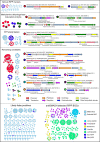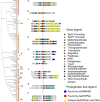Expansion of RiPP biosynthetic space through integration of pan-genomics and machine learning uncovers a novel class of lanthipeptides
- PMID: 33351797
- PMCID: PMC7794033
- DOI: 10.1371/journal.pbio.3001026
Expansion of RiPP biosynthetic space through integration of pan-genomics and machine learning uncovers a novel class of lanthipeptides
Abstract
Microbial natural products constitute a wide variety of chemical compounds, many which can have antibiotic, antiviral, or anticancer properties that make them interesting for clinical purposes. Natural product classes include polyketides (PKs), nonribosomal peptides (NRPs), and ribosomally synthesized and post-translationally modified peptides (RiPPs). While variants of biosynthetic gene clusters (BGCs) for known classes of natural products are easy to identify in genome sequences, BGCs for new compound classes escape attention. In particular, evidence is accumulating that for RiPPs, subclasses known thus far may only represent the tip of an iceberg. Here, we present decRiPPter (Data-driven Exploratory Class-independent RiPP TrackER), a RiPP genome mining algorithm aimed at the discovery of novel RiPP classes. DecRiPPter combines a Support Vector Machine (SVM) that identifies candidate RiPP precursors with pan-genomic analyses to identify which of these are encoded within operon-like structures that are part of the accessory genome of a genus. Subsequently, it prioritizes such regions based on the presence of new enzymology and based on patterns of gene cluster and precursor peptide conservation across species. We then applied decRiPPter to mine 1,295 Streptomyces genomes, which led to the identification of 42 new candidate RiPP families that could not be found by existing programs. One of these was studied further and elucidated as a representative of a novel subfamily of lanthipeptides, which we designate class V. The 2D structure of the new RiPP, which we name pristinin A3 (1), was solved using nuclear magnetic resonance (NMR), tandem mass spectrometry (MS/MS) data, and chemical labeling. Two previously unidentified modifying enzymes are proposed to create the hallmark lanthionine bridges. Taken together, our work highlights how novel natural product families can be discovered by methods going beyond sequence similarity searches to integrate multiple pathway discovery criteria.
Conflict of interest statement
I have read the journal's policy and the authors of this manuscript have the following competing interests: P.C. is currently an employee of Verily Life Sciences. M.H. is currently an employee of LifeMine Therapeutics. M.S.D. is a member of the Scientific Advisory Board of DeepBiome Therapeutics. M.A.F. is a cofounder and director of Federation Bio. M.H.M. is on the scientific advisory board of Hexagon Bio and co-founder of Design Pharmaceuticals.
Figures




References
-
- Davies J. Origins and evolution of antibiotic resistance. Microbiologia. 1996;12 (1):9–16. - PubMed
Publication types
MeSH terms
Substances
LinkOut - more resources
Full Text Sources
Other Literature Sources
Miscellaneous

